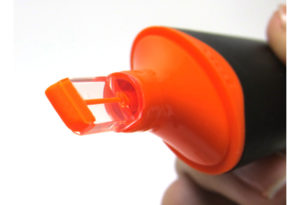Imagine you’re a highlighter manufacturer. You come into work, and see that everything is working perfectly: the shades are fluorescent, the ink does not smudge, and the marker does not dry out.
Then, your manager arrives and says, “let’s mix it up here, and add a clear window to the tip so users can see what they’re highlighting.” You might be alarmed. “Why would we change what already works?” You can thank usability.

Like a masked superhero, usability is a behind-the-scenes process that yields visible results. But what is it?
Usability means “…making products and systems easier to use, and matching them more closely to user needs and requirements.”1 In other words, usability is a way that you can improve your product or website simply by listening to user feedback.
Usability and websites go hand in hand. So why should you care about it?
Now that you know why usability is crucial, here’s the good news: a little goes a long way. A good place to start your website’s usability test is customer feedback surveys, feedback boxes, monitoring your social media presence, or directly reaching out to customers asking for feedback. The best part about these methods is that they’re all low-cost and fairly simple to set up.
Before jumping into your test, arm yourself with a few usability lessons I’ve learned the hard way over the years:

As with many things in life, you can’t measure success without knowing where you started. It’s critical to take stock of key metrics before the usability test, and after usability changes were made. Not measuring your baseline takes away from your grand finale of showing how you’ve enhanced the website, and who wants that?
In order to know your user success rates for completing tasks, you have to know how your company defines success. Is it donating to a cause, purchasing a product, or searching for a topic? Reflect on your website’s goals and how it translates to user success, and you’re halfway there. Once you know how you’ll measure success, look at metrics that can help you measure progress. Google Analytics is a great start, tracking page views, site views, bounce rates, average time on site, and percentage of new visitors.

Some things just don’t mix, like black turtlenecks and “The Rock.” What else doesn’t mix? Biases and surveys.
One way biases can creep into your surveys is through loaded questions. Loaded questions throw people off (because you assume the question applies to them) and is a major reason why people abandon surveys.
Another point to be aware of is making sure your questions are as neutral as possible. Good practice is avoiding words charged with heavily positive or negative emotions, and words that can hold strong connotations, such as “bossy” (negative connotation) or “confident” (positive connotation).

They’re the ones using the website, after all.
When you get feedback you don’t agree with, you may want to take the easy way out and blame the user, saying they’re not tech savvy enough. But that is the easy way out.
During a usability test I did, I thought the website was well designed because it provided tons of detail; however, my users felt otherwise. This was valuable feedback that I could have discredited as the user being flighty. Instead, I saw this as an opportunity to reorganize the content so users knew exactly what we were asking them to do.
Look to see if there are patterns with the user feedback. Is the navigation confusing? Can they not find important information? Do they wait forever for a page to load?

You may think your website is your baby, and who likes being told their baby is ugly? During usability tests, I still have to remind myself that the criticism isn’t personal; it’s necessary for growth.
Take a deep breath, swallow your countercriticisms, and welcome user feedback as one step closer to a better website. Think about your organization’s goals, and use feedback to work towards them.
What should you do when you are barraged with negative feedback? Step one, keep your cool. Instead of getting defensive, thank the user for their insight and feedback. Step two, ask constructive questions that could give you ideas for a solution. Make sure you’re actively listening (listening not only to hear, but to understand). Step three, let the user know that you are committed to improvements and will take their feedback into consideration. Make sure they understand their efforts are appreciated.

So, weeks later, you’ve gathered so much feedback you feel faint. Great! Now comes the fun part – what are you going to do with it?
Interpreting user feedback and brainstorming concrete ways to transform abstract critiques is arguably the most important step. If user feedback is why you’re improving your website, interpreting user feedback is how your website improves.
Before you brainstorm solutions, you have to organize your data. A simple way to do this would be separating the positive and negative comments. Look at what was said, and think of the steps needed to remedy the negative comments. If users said that they could not find where they could donate, perhaps you could place a button in a prominent spot on the page. If you want to really go above and beyond, you can a/b test different button colors and locations, and see which one users like best.
But what if thinking of solutions leaves you drawing a blank?
***
Oftentimes, there is no clear cut solution to user feedback, and it requires another usability test focused on learning more about these issues. This was my conclusion for my first usability test. Just because one usability test requires another usability to find a viable solution does not mean you did it wrong – in fact, quite the opposite.
Usability should never stop. There are always clarifications to be made, continuously changing technologies, and feedback about new website implementations. Valuing user feedback not only advances your organization’s goals; it also shows that you care about your users’ opinions.
Sign up today to have our latest posts delivered straight to your inbox.